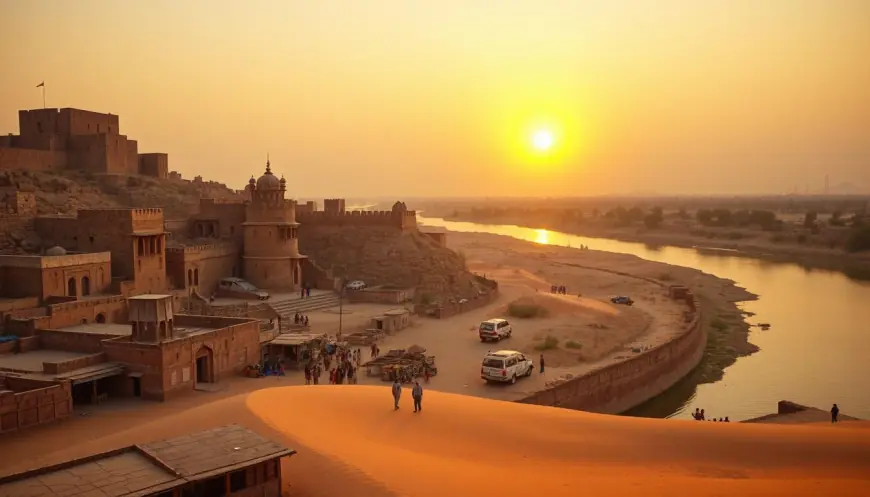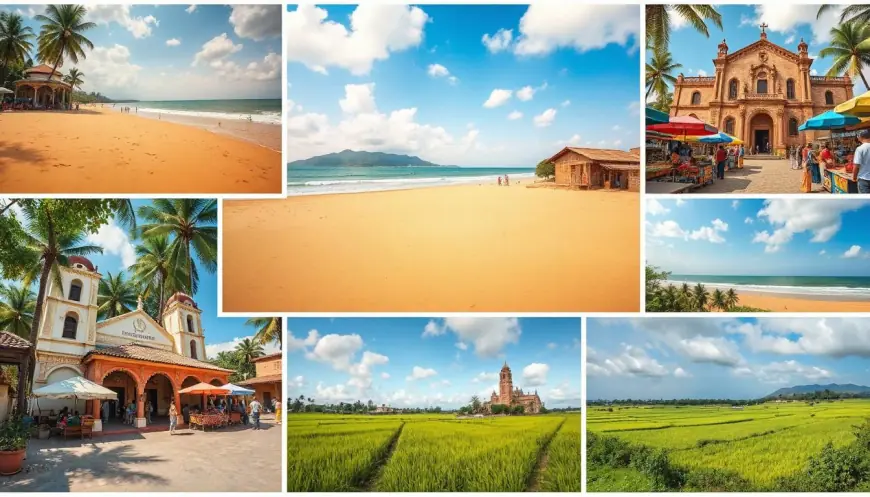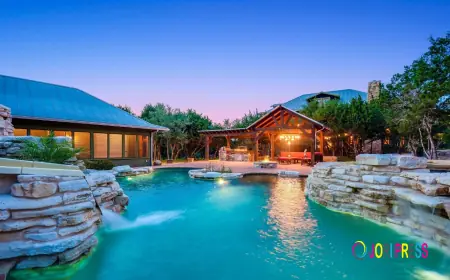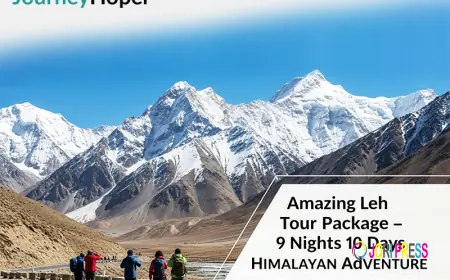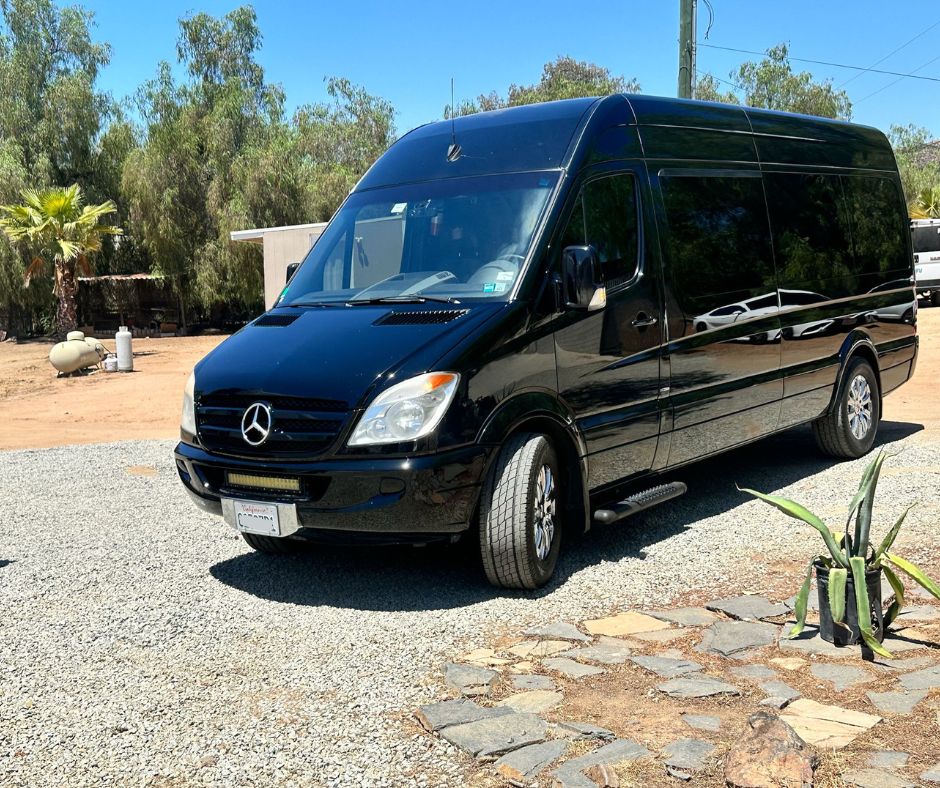Hanumangarh in Monsoon: A Rainy Retreat You Didn’t Expect
Explore the beauty of Hanumangarh in monsoon with cultural gems, green landscapes, and historical charm. Discover why Hanumangarh is a must-visit this rainy season.
When you think of Rajasthan, images of dry deserts, camel rides, and blazing summer heat likely come to mind. But have you ever imagined what this land of royalty looks like when it rains? One destination that undergoes a magical transformation during the monsoon is Hanumangarh—a hidden gem that most travelers overlook. Located in the northern part of Rajasthan near the Punjab border, Hanumangarh offers a unique blend of historical richness, spiritual depth, and monsoon charm.
If you’re looking for an offbeat destination to explore this rainy season, Hanumangarh in monsoon might just surprise you. From ancient forts shrouded in mist to lush green fields that stretch endlessly, the city offers more than what meets the eye.
In this blog by Adotrip, we take you on a virtual tour of Hanumangarh during monsoon, explore must-visit spots, local experiences, weather tips, and travel hacks to make the most of your journey.
1. Why Visit Hanumangarh in the Monsoon?
The months from July to September bring a gentle spell of rainfall to Hanumangarh, washing the arid landscape in shades of green. The monsoon rain turns the dry terrain into a fresh and picturesque region. The rivers swell slightly, birds return in flocks, and historical ruins come alive with moss and cool winds. It’s the perfect time to:
-
Enjoy less tourist traffic
-
Capture rare natural beauty in a semi-arid landscape
-
Experience local culture more intimately
-
Walk through historical ruins without the harsh sun
Hanumangarh in monsoon becomes a paradise for photographers, nature lovers, and spiritual seekers alike.
2. A Glimpse into Hanumangarh’s Historical Roots
Originally known as Bhatner, Hanumangarh has a rich history dating back to the era of the Mauryan Empire. The city was once ruled by Rajputs, Delhi Sultans, Mughals, and even the British. Its historical significance deepens with the discovery of ancient Harappan sites like Kalibangan nearby—making it one of the few places in India connecting modern civilization to the Indus Valley Civilization.
Must-Visit Historical Sites in Hanumangarh:
-
Bhatner Fort: Built in the 3rd century by Bhupat, this red sandstone fort becomes especially scenic when rain falls on its ancient walls.
-
Kalibangan Archaeological Site: Located just 30 km away, it offers insights into pre-Harappan and Harappan settlements, enhanced in beauty during monsoon.
-
Temple of Bhadrakali: Known for its mythological roots and spiritual energy, it offers a serene experience amidst monsoon winds.
3. Nature and Greenery in Monsoon
Though Rajasthan is primarily dry, Hanumangarh in monsoon is an exception. The rainfall, though not heavy, is enough to bring life back to the fields and orchards. This region is agriculturally rich, and during monsoon, mustard and cotton fields glisten under cloudy skies.
Best Natural Experiences:
-
Birdwatching near Ghaggar River
-
Walking trails through mustard fields post rainfall
-
Village life photography with monsoon backdrops
Tip: Head out early morning or post-rain for the best lighting and landscape visuals.
4. Local Experiences You Can’t Miss in Monsoon
Traveling to Hanumangarh isn’t just about monuments—it's about moments. And monsoon is when the locals are at their most welcoming. Farmers sip chai under cloudy skies, kids play in muddy fields, and the air smells of rain-soaked earth. Here’s how you can immerse yourself in authentic experiences:
-
Enjoy local delicacies like Dal Baati Churma or Bajre ki Khichdi in village dhabas.
-
Participate in folk songs and dances which often take place during seasonal festivals like Teej or Sawan.
-
Visit local markets in the rain to buy ethnic handicrafts, silver jewelry, and traditional fabrics.
5. Monsoon Travel Tips for Hanumangarh
Before you pack your bags, here are a few smart tips to keep in mind for visiting Hanumangarh in monsoon:
| Tip Category | Recommendation |
|---|---|
| Clothing | Light cottons, waterproof jacket, umbrella, and comfortable walking shoes. |
| Transport | Use local autos or book cabs in advance; roads may be slippery. |
| Accommodation | Opt for heritage stays or local hotels with good drainage systems. |
| Photography Gear | Carry waterproof bags for camera equipment. |
| Health | Keep mosquito repellents and drink only bottled water. |
6. Cultural & Religious Highlights in the Rainy Season
During monsoon, temples and spiritual sites in Hanumangarh draw a quiet stream of pilgrims and seekers. The rainy weather adds an extra layer of peace and mysticism to the experience.
Top Religious Sites to Visit:
-
Bhadrakali Temple – Said to be among the Shakti Peeths.
-
Temple of Gogaji – A folk deity worshipped especially during monsoon.
-
Kalibangan Shivalaya – A sacred spot dating back to Harappan era.
7. Offbeat Monsoon Activities in Hanumangarh
Want to go beyond sightseeing? Try these monsoon-friendly ideas:
-
Picnic at Talwara Lake (if filled after rainfall)
-
Attend a rural fair or cattle market
-
Village stay for a weekend monsoon retreat
-
Clay pottery and craft-making experiences
These little gems make Hanumangarh a destination, not just a stopover.
8. How to Reach Hanumangarh
Hanumangarh is well-connected by road and rail. During monsoon, trains are often the most reliable mode of travel.
-
By Train: Hanumangarh Junction is connected to Delhi, Bikaner, Jaipur, and Chandigarh.
-
By Road: You can drive from Delhi (7 hrs) or Jaipur (8 hrs) via NH 62.
-
By Air: Nearest airports are Bathinda (100 km) and Bikaner (120 km).
9. Ideal Itinerary for Monsoon in Hanumangarh
Here’s a quick 3-day itinerary you can follow:
Day 1:
-
Arrival and check-in
-
Visit Bhatner Fort
-
Local market walk post-rain
-
Evening aarti at Bhadrakali Temple
Day 2:
-
Day trip to Kalibangan
-
Lunch at a roadside dhaba
-
Rainy evening chai at a rooftop café
Day 3:
-
Early morning birdwatching
-
Shopping for crafts and local sweets
-
Depart
10. Sustainable Travel Tips for Monsoon
-
Avoid plastic bottles—carry your own.
-
Respect religious spaces during prayer times.
-
Don’t litter near archaeological sites.
-
Support local artisans and guides.
-
Avoid overcrowded areas during festivals.
11. Why Hanumangarh Is a Hidden Monsoon Treasure
In a land celebrated for its deserts and palaces, Hanumangarh offers a refreshing detour. The rains don’t just revive the soil—they breathe life into stories, songs, and forgotten corners of history. For the traveler who seeks more than just tourist attractions, Hanumangarh in monsoon is a story waiting to be discovered.
Whether you're a solo backpacker, a history buff, or a monsoon romantic, this unassuming town offers a side of Rajasthan rarely talked about.
✅ Frequently Asked Questions (FAQs)
1. What is the best time to visit Hanumangarh?
The best time is from July to September for monsoon lovers, or from October to February for winter comfort.
2. Is Hanumangarh safe for solo travelers?
Yes, it’s a peaceful town with friendly locals. Basic safety precautions should still be followed.
3. How many days are enough to explore Hanumangarh?
2 to 3 days are ideal to explore the main attractions and enjoy local culture.
4. Are there any festivals during monsoon in Hanumangarh?
Yes, local festivals like Teej and Sawan are celebrated with devotion and music.
5. Can I visit Kalibangan during monsoon?
Absolutely. The archaeological site looks stunning with rain-soaked soil and green cover.
6. What should I pack for Hanumangarh in monsoon?
Umbrella, raincoat, waterproof footwear, light clothes, camera, and medicines.
7. Are hotels open during monsoon in Hanumangarh?
Yes, most accommodations function year-round. It's advised to pre-book during festivals.
8. How’s the food scene in Hanumangarh?
Local Rajasthani food is a must-try. Street food and dhabas serve authentic cuisine.
9. What is the local language spoken in Hanumangarh?
Hindi and Rajasthani are commonly spoken. English is understood at tourist spots.
10. Are there guided tours available?
Yes, you can hire local guides or check with your hotel for package tours.
11. Does it rain heavily in Hanumangarh?
No, the region receives moderate rainfall, just enough to turn the area lush and green.
12. Is Hanumangarh a good destination for photography?
Absolutely. From forts to fields, monsoon adds dramatic flair to every frame.
13. Are there any local souvenirs to buy?
Yes, handicrafts, silver jewelry, tie-dye fabrics, and miniature art are worth buying.
14. Can families with kids enjoy Hanumangarh in monsoon?
Yes, it’s a family-friendly destination with plenty of cultural and historical interest.
15. Is Hanumangarh worth visiting over more popular cities like Jaipur or Udaipur?
If you're looking for peace, authenticity, and an offbeat monsoon retreat—then definitely yes!
Plan Your Rainy Escape with Adotrip ?️
At Adotrip, we believe travel should be about discovering the undiscovered. Hanumangarh in monsoon is not just a destination—it's a feeling. Let us help you plan a scenic, safe, and soulful escape with our custom itineraries, bookings, and expert travel tips.
Discover. Experience. Remember. Only with Adotrip.
What's Your Reaction?
 Like
0
Like
0
 Dislike
0
Dislike
0
 Love
0
Love
0
 Funny
0
Funny
0
 Angry
0
Angry
0
 Sad
0
Sad
0
 Wow
0
Wow
0









































